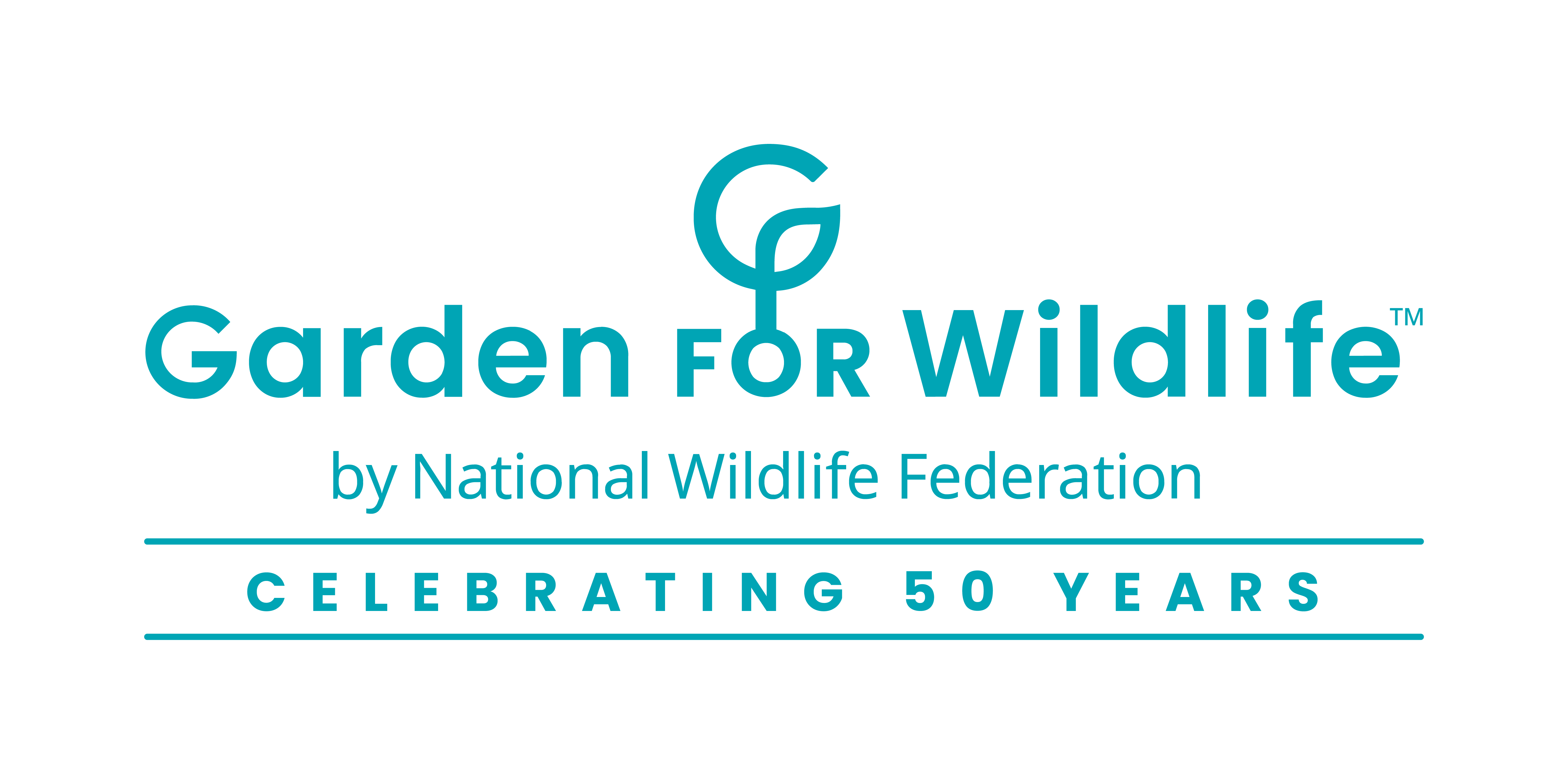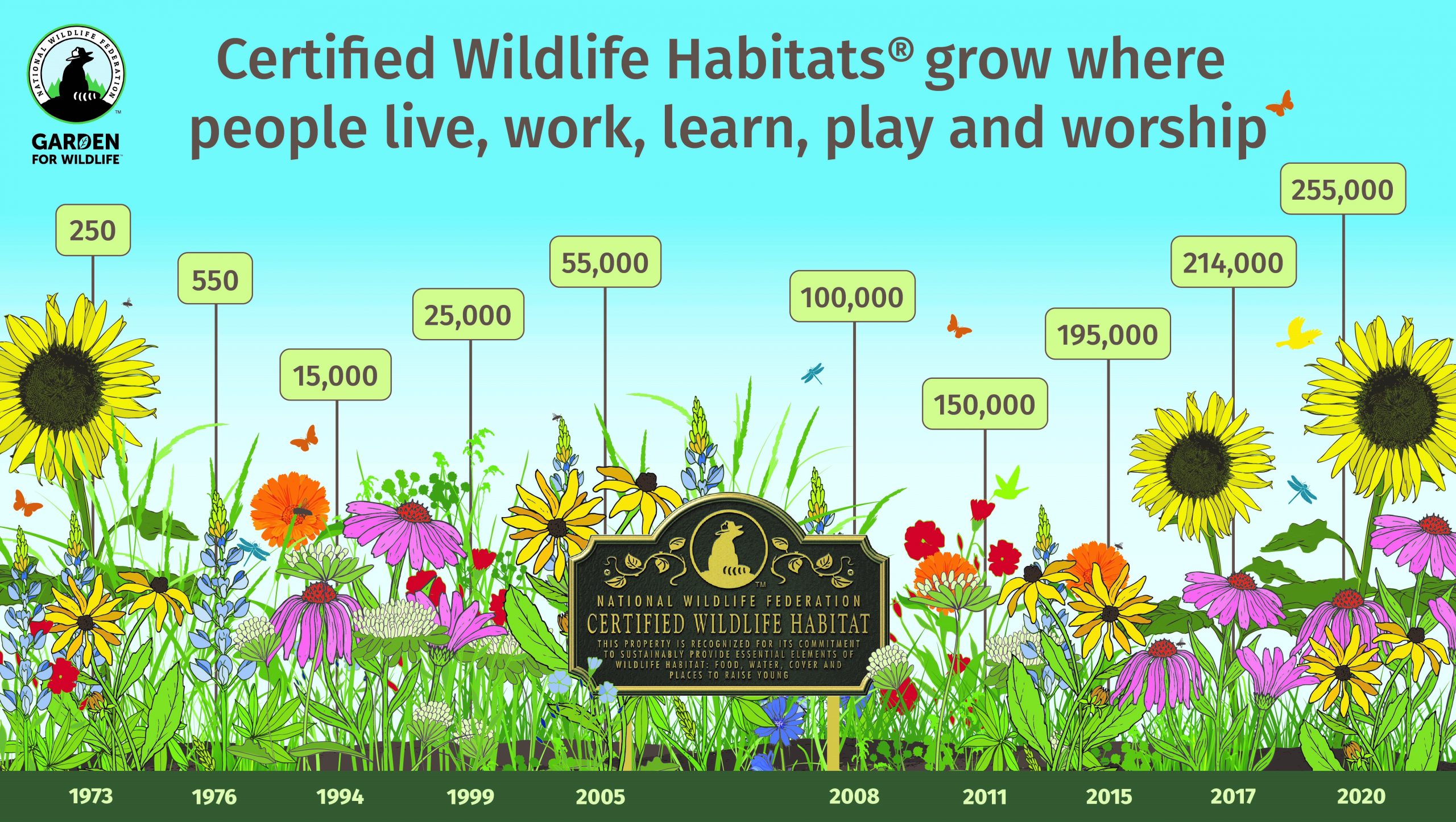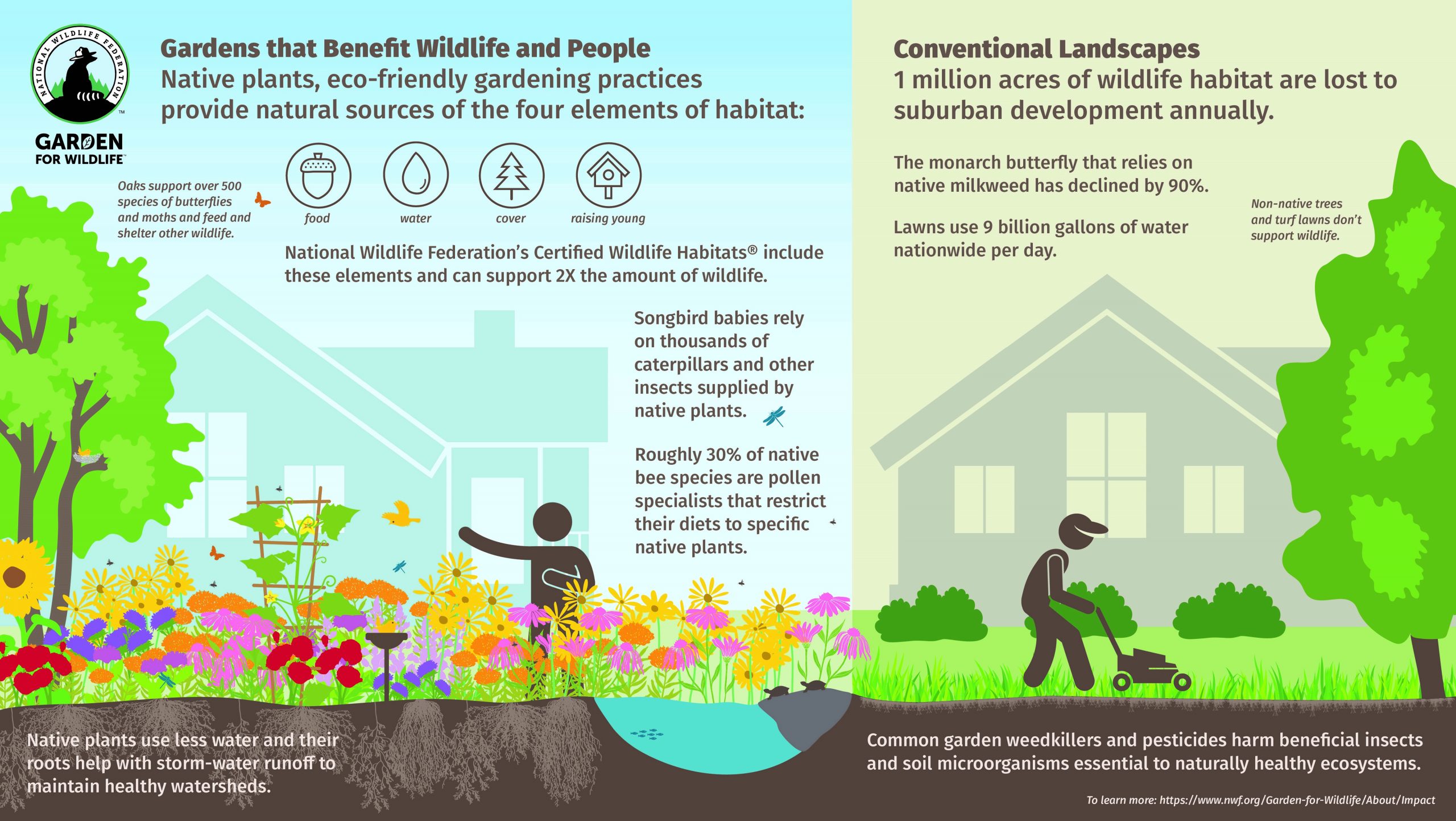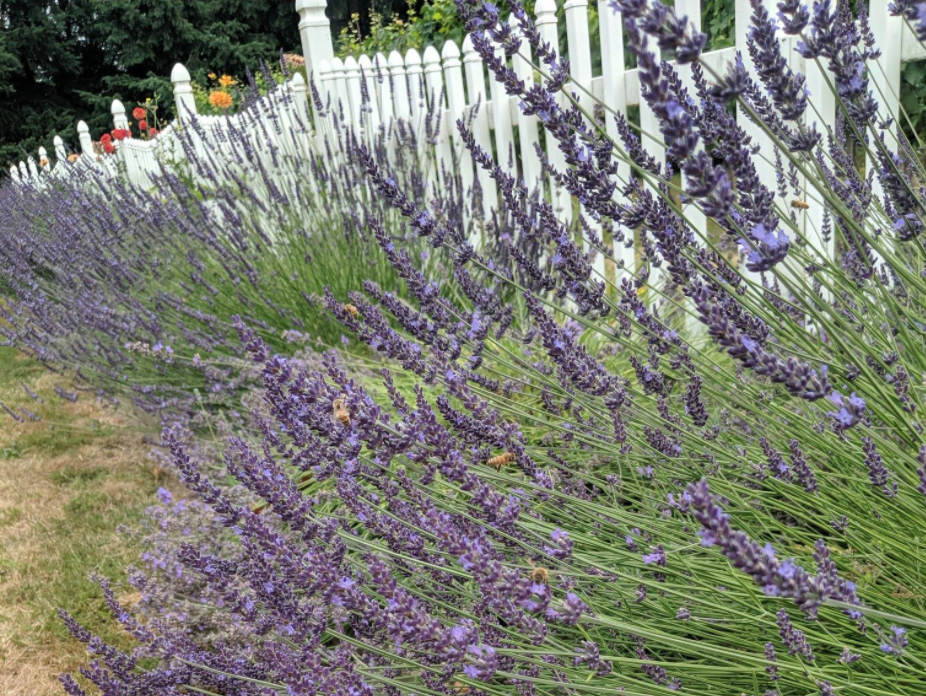Garden for Wildlife
Certified Wildlife Habitats


What are Certified Wildlife Habitats?
A certified wildlife habitat uses sustainable gardening practices to provide food, water, cover, and places to raise young for local wildlife.
The Association of Northwest Steelheaders is teaming up with National Wildlife Federation’s Garden for Wildlife program to transform backyards, school grounds, places of worship, businesses, and community spaces into Certified Wildlife Habitats. Since 1973, the Garden for Wildlife program has empowered people to invite wildlife back into their neighborhoods by converting their gardens, both large and small, urban and rural, into habitat for local pollinators, birds, and other wildlife. Every habitat garden is a step toward replenishing resources for wildlife throughout Oregon’s watersheds, forests and urban areas. Celebrating 50 years in 2023, Garden for Wildlife has grown to influence the creation of an estimated 4 million wildlife friendly acres of backyards, public gardens, school districts, corporate campuses, colleges and universities, places of worship and community spaces across North America and at embassies across the world.
The Northwest Steelheaders recognize that in order to ensure thriving populations of fish for future generations, we need to protect the habitat conditions upon which these species depend. In spending our free time along rivers and lakes, anglers are able to clearly witness the adverse effects of pollution, runoff, and high water temperatures. Strong salmon and steelhead runs rely on cold and clean water flowing through healthy riparian areas. By creating wildlife gardens and cultivating native plants in our communities, we are helping to prevent soil erosion, reduce runoff, and ultimately provide healthy salmon habitat conditions downstream. Sustainable gardens = healthy water = happy fish!
Certify Your Outdoor Space
There are over 4,000 Certified Wildlife Habitats in Oregon, and the list keeps on growing!
Animals aren’t the only ones who benefit from the Garden for Wildlife Program. When you certify your outdoor space, you become a member of NWF’s Garden for Wildlife community and receive various benefits, including a personalized certificate, a one-year membership in the National Wildlife Federation and subscription to National Wildlife Magazine, 10% off the magazine catalog’s merchandise, subscription to monthly Garden for Wildlife e-newsletter, and the exclusive option to purchase attractive garden signs.
A portion of your $20 application processing fee (waived for schools) goes to supporting programs that educate children and adults on how to make a difference for salmon and wildlife. We also encourage you to purchase and proudly display a Certified Wildlife Habitat sign, which now sports an Association of Northwest Steelheaders logo. For every certification in Oregon, the Steelheaders receive $5. By displaying this sign in your beautiful garden, you may inspire your friends and neighbors to create their own Gardens for Wildlife.
Certify in May and June for 20% off when you register and purchase a yard sign. Use code GARDEN20.Protect Monarch Butterflies and Other Pollinators
Take the Mayors' Monarch Pledge!
Like salmon, the monarch butterfly is a beloved and iconic keystone species whose population health can be an indicator of the troubling decline of ecosystems. And like salmon, they too depend on healthy river corridors for habitat and migration that are affected by what people do in their own backyards and gardens. Whether it’s applying pesticides, removing native trees, planting non-natives, polluting waters, or other activities – these can have a detrimental impact on water quality and wildlife species survival. Alarmingly, western monarch butterfly populations have plummeted by more than 95% since the 1980s. The Xerces Society’s annual Western Monarch Thanksgiving Count, which monitors population numbers at overwintering sites along coastal California, reported 335,479 monarchs in 2022. However, the New Year's Count report of 116,758 monarch butterflies indicated a 58% seasonal decline between the Thanksgiving and New Year's counts during a period of severe winter storms along the California coast. This emphasizes how vulnerable monarch populations are to a combination of factors including climate change impacts.
The good news is that communities across the west can all play a critical role in saving the monarch butterfly and other pollinators for generations to come! Through the National Wildlife Federation’s Mayors' Monarch Pledge, mayors and other heads of local and tribal government can take action to create sustainable habitat for the monarch butterfly and educate their community on the importance of pollinators and ways they can help. Learn more about the Mayors’ Monarch Pledge program and invite your mayor to take the pledge today and join a growing list of communities across the country pledging to protect monarchs. As youth advocates, students are also encouraged to engage their community leaders. Pledges are accepted December 1-April 30 each year. Read about NWF staff experiences visiting Pismo State Beach Monarch Butterfly Grove, CA, in Treasure at Pismo Beach. 2023 Pledge Communities in Oregon: Salem, Hillsboro, Oregon City! Learn more through our Fact Sheet and Impact Report. Check out our Guide to Issuing Proclamations for Healthy, Sustainable, Wildlife-Friendly Communities and How to Provide Water in Monarch Gardens as well as templates, webinars, and other resources. Check out these fact sheets from the Western Association of Fish and Wildlife Agencies for more ways you can help monarchs Questions? Contact Morgan Parks, NWF Oregon Education Manager, parksm@nwf.org or 503-616-3613.Creating your Wildlife Habitat
To certify, your wildlife habitat must provide food, water, cover, and places to raise young while using sustainable gardening practices. Use this easy checklist to determine which components your garden already provides. When you are ready to certify, you can do so online or download this brochure application and mail it in.
Food: Grow native plants to provide sources of food year-round for birds, butterflies, other pollinators, and wildlife species.
Water: All animals need water to survive, and some need it for bathing or breeding. Try providing a bird bath, shallow water dish, pond, or rain garden.
Cover: Wildlife need places to find shelter from bad weather and to hide from predators. Your garden habitat might include a rock pile, roosting box, or logs.
Places to Raise Young: Wildlife require secure places to raise their young, such as nests, nooks and crannies in rocks, or brush piles.
Sustainable Practices: The gardening practices you use at home, in your garage, and in your yard can affect the health of the soil, air, water, and habitat.
Does your outdoor space already provide these wildlife-friendly elements? Certify your garden today! If you are creating a new garden, design it with wildlife in mind. For more information on creating your habitat garden, go to the National Wildlife Federation’s Garden for Wildlife website, or use the resources listed below.Contact us at ORHabitat@nwf.org with any questions.

NWF Resources and Related Programs
Gardening and Wildlife Species
- Marine West Coast Forests - Commercially Available Host Plants for Butterflies and Moths
- Maritime NW Monarch Plant List
- Butterfly Heroes Campaign
- Mayors Monarch Pledge
- Beesponsible
- Million Pollinator Garden Challenge
- Trees for Wildlife
- Garden for Wildlife Resources and Tip Sheets
- Wildlife Guide
- Garden for Wildlife Native Plant Collections
- Gardening for Climate Change
Education
- Schoolyard Habitat Planning Guide, Urban Pollinator Curriculum, and Garden Seed Kit Brochure
- Create a Schoolyard Habitat for Monarchs and Other Pollinators
- Eco-Schools USA Schoolyard Habitats Pathway
- Educator Tools
- Monarch Mission Curriculum (PK-12, English and Spanish)
- Early Childhood Health Outdoors (ECHO) How-to-Guide
- Virtual Classroom Resources
- Nature Notebooks - Ranger Rick
- Schoolyard Habitat Worksheets and Activities – National Wildlife Federation
Wildlife Crafts
- Buzzworthy Mason Bee Condos
- Garden for Wildlife Pollinator Origami Chatterbox (Kids Fortune Teller)
- Salmon Life Cycle Origami Chatterbox (Kids Fortune Teller)
- Wildlife Salt Painting
- Wild About Stampin'
- Scavenging for Species
- Schooled on Salmon
- A Cauldron of Bats
- Winter Wonderland - Log Cabin and Gingerbread Wildlife Habitat
- Crafting for Critters: Holiday Habitat (Miniature Fairy Gardens)
Other Partner Resources
Wildlife
- A Guide to Priority Plant and Animal Species in Oregon Forests – The Oregon Forest Research Institute
- Wildlife Viewing – Oregon Department of Fish and Wildlife
- How to be a Salmon Friendly Gardener – Snohomish County Public Works
- Living With Wildlife – Oregon Department of Fish & Wildlife
- Pollinator Syndromes – North American Pollinator Protection Campaign
- Pollinator-Friendly Parks - Xerces Society
- Western Monarch Call to Action - Xerces Society
- Oregon Monarch Updates - Western Monarch Advocates
- Bees of Portland Pocket Guide – Xerces Society
- Beneficial Insect Plants of the Pacific Northwest – Beyond Toxics
Native Plants
- PlantNative - List of Native Plant Nurseries in Oregon
- Native Plant Society of Oregon - List of Native Plant Nurseries
- Bosky Dell Natives – Nursery in West Linn
- Native Plants Gardening – Oregon State University Extension Service
- USDA Attracting Pollinators to Your Garden Using Native Plants – US Forest Service
- Local Sources of Native Plants – East Multnomah Soil and Water Conservation District
- Portland Plant List - Bureau of Planning and Sustainability
- Native Plants for Willamette Valley Yards – Oregon Metro
- Recommended Native Plants for Home Gardens in Western Oregon – Oregon State University Extension Service
- Oregon Milkweed Guide – Xerces Society
- Gardening with Oregon Native Plants West of the Cascades - OSU Extension Service
- Maritime NW Pollinator Plant List - Xerces Society
- Oregon Flora Native Plants
- Native Plant Poster - City of Portland Bureau of Environmental Sciences
Invasive Plants
- Invasive Plants of the Portland Area – City of Portland Bureau of Environmental Services
- Invasive Plants Poster - City of Portland Bureau of Environmental Services
- Weeds to Know - East Multnomah Soil and Water Conservation District
Sustainable Gardening Practices
- Backyard Habitat Certification Program – Audubon Society of Portland
- Parting with Pesticides – Clackamas River Basin Council
- Water Conservation Tips – East Multnomah Soil & Water Conservation District
- Working Near Water – East Multnomah Soil & Water Conservation District
- Water-wise Gardening in Central Oregon – Oregon State University Extension Service
- Xeriscaping in the High Desert – Oregon State University Extension Service
- Beneficial Insects, Spiders, and Other Mini-Creatures in Your Garden - Washington State University Extension
- Grow Smart Grow Safe - Thurston County Public Health and Social Services
- The Oregon Rain Garden Guide – Sea Grant Oregon
Other Education Resources and Curriculum
- From Salmonberry to Sagebrush – Institute for Applied Ecology
- Project WILD - Association of Fish and Wildlife Agencies
- Schoolyard Activity Guides - Green Schoolyards America
Signs
- Garden Signs (Made in Oregon) – Victory Garden of Tomorrow
- Pollinator Habitat Sign – Xerces Society
- Monarch Waystation Program – Monarch Watch




